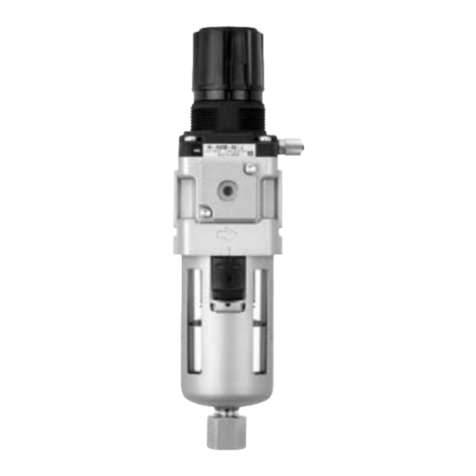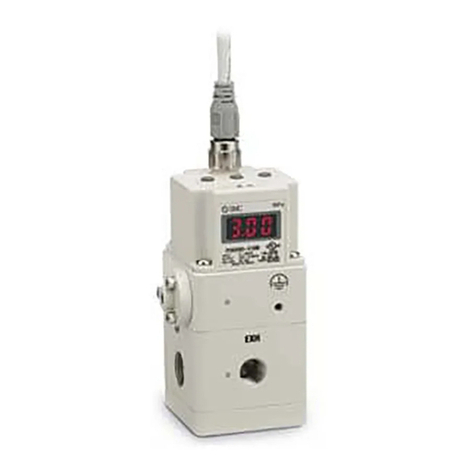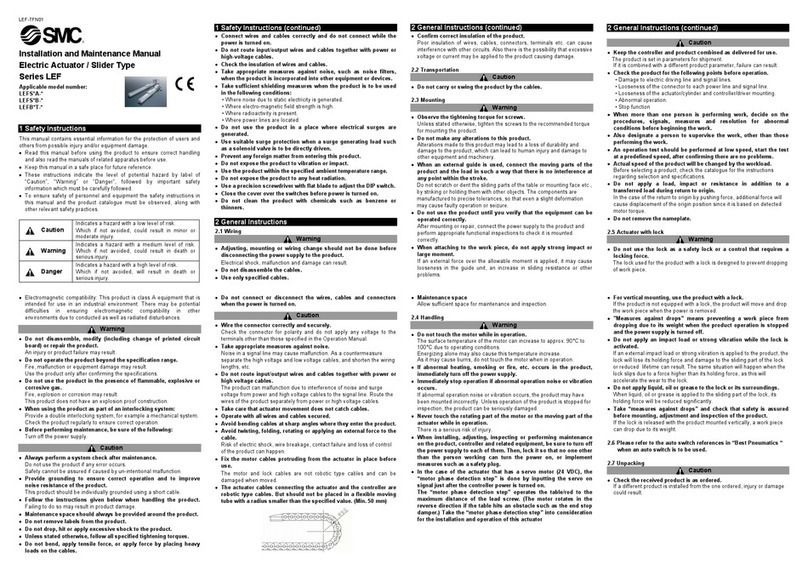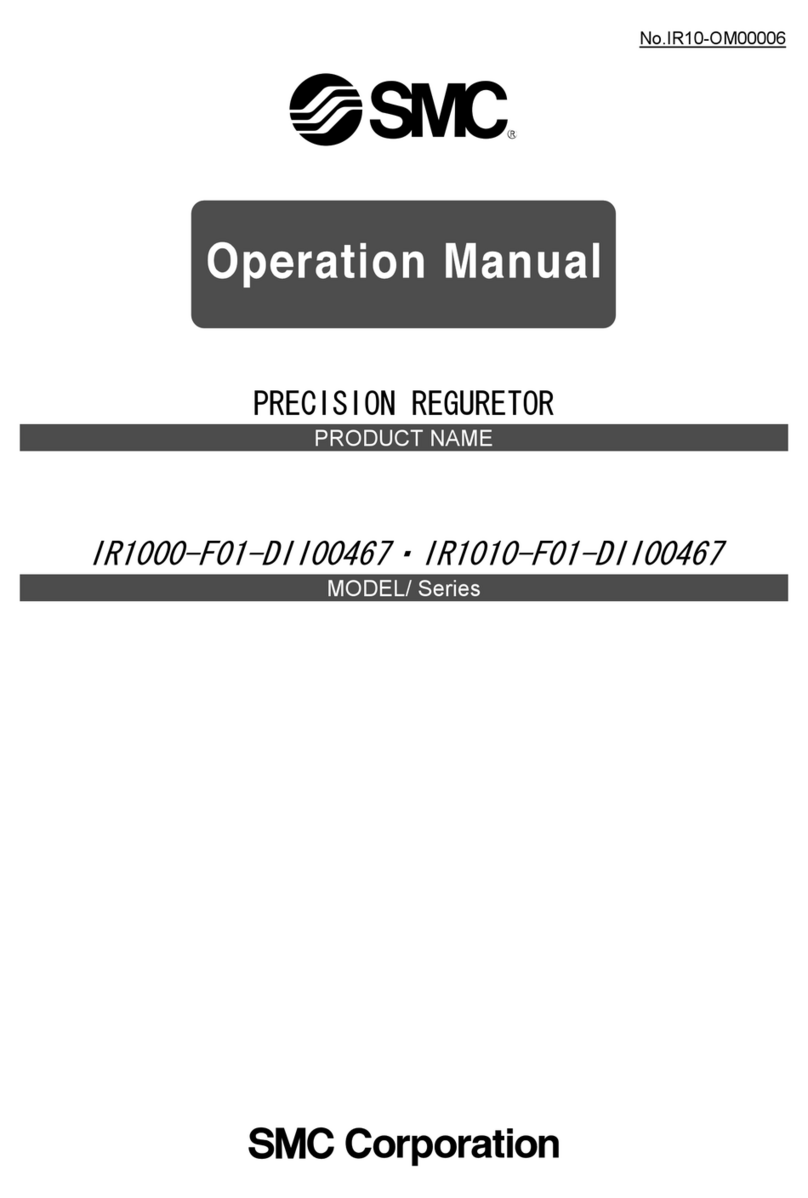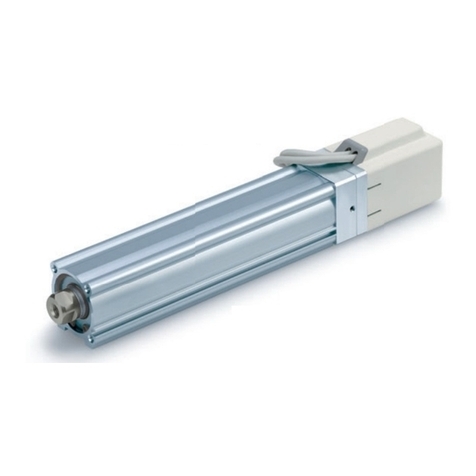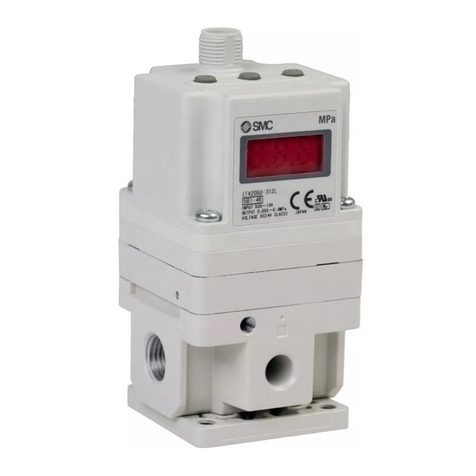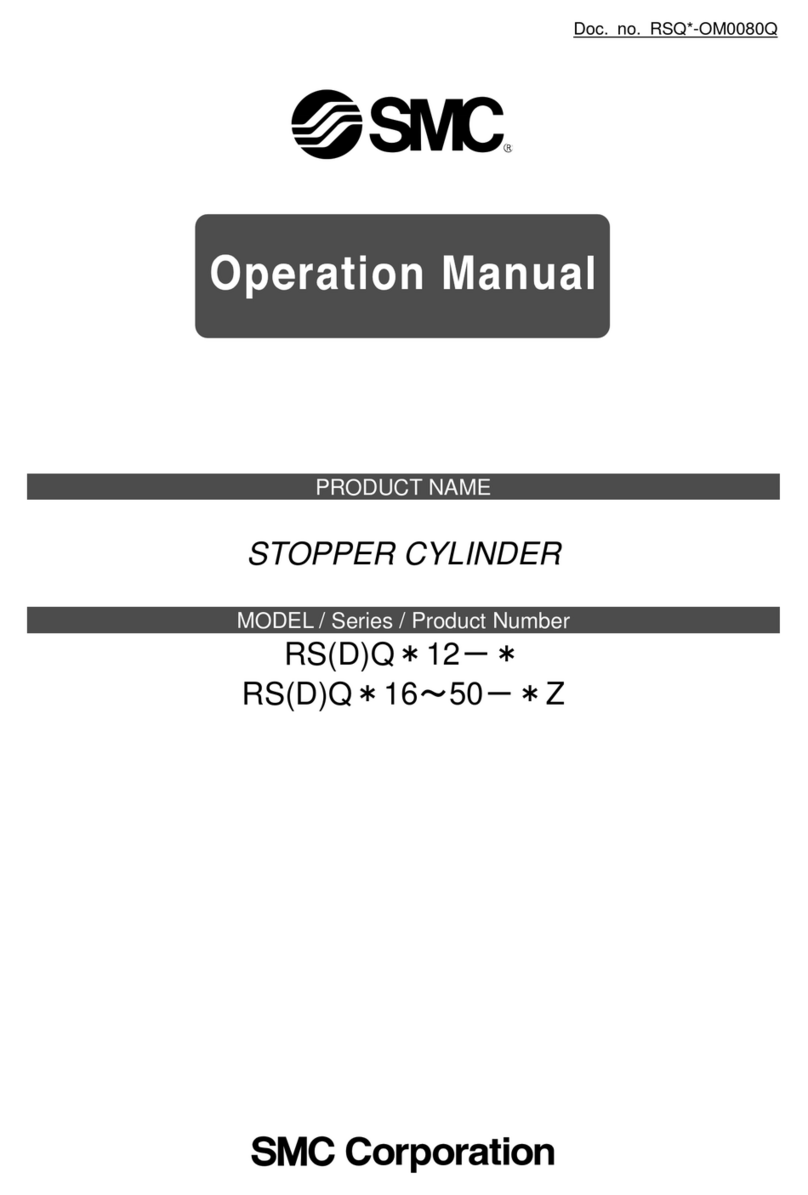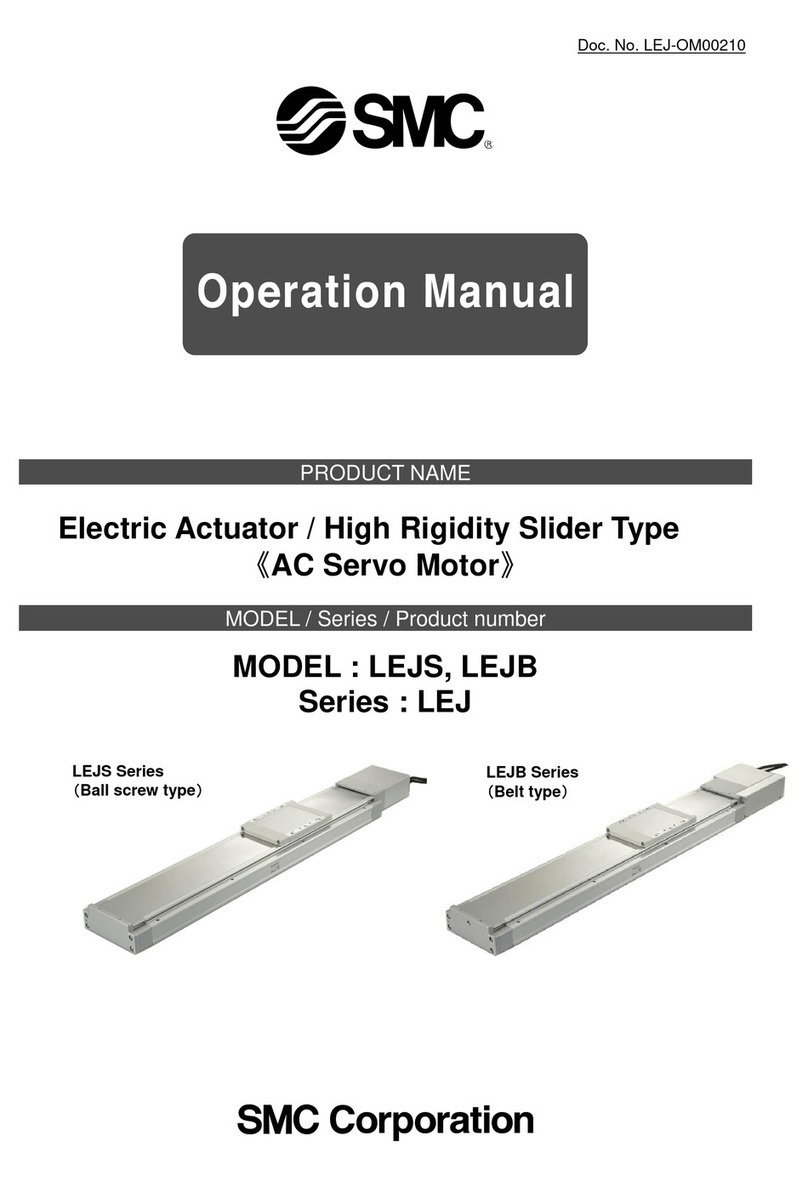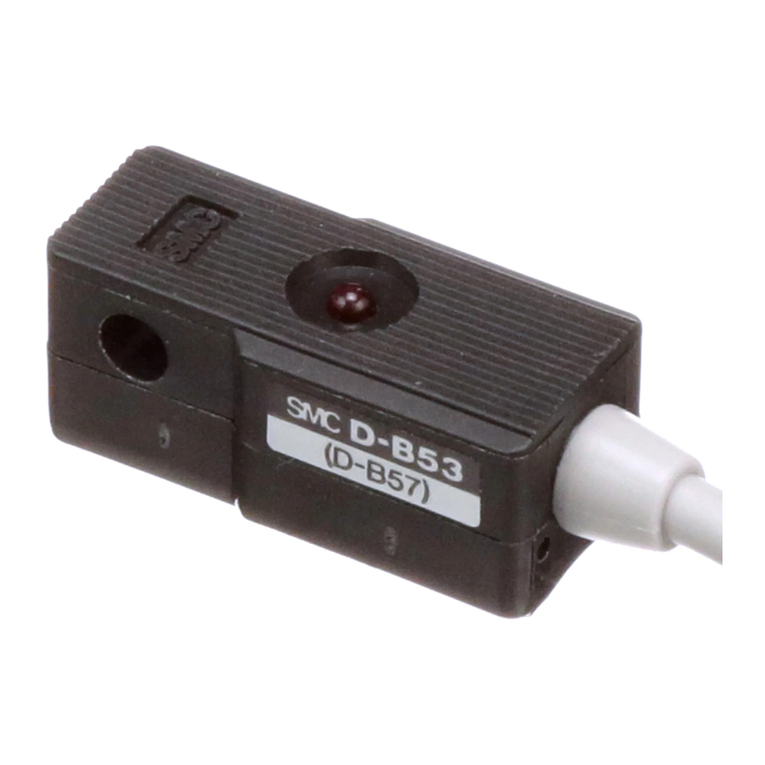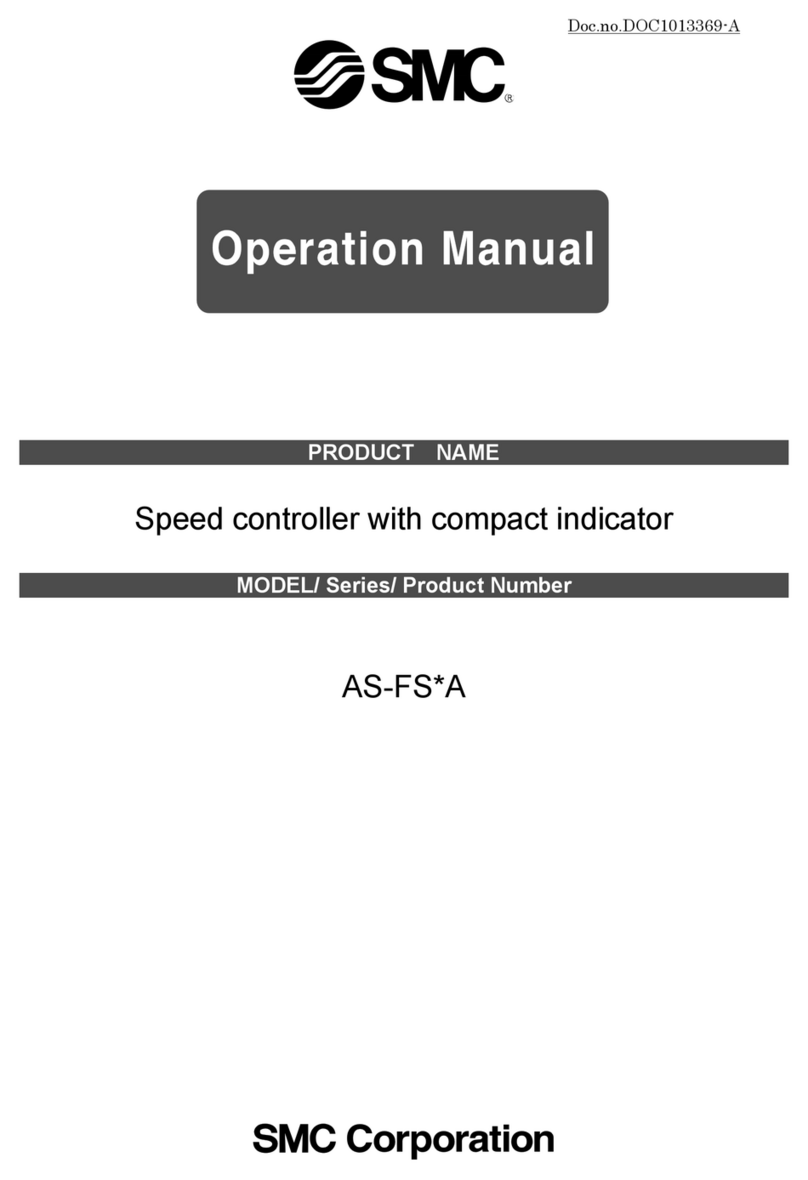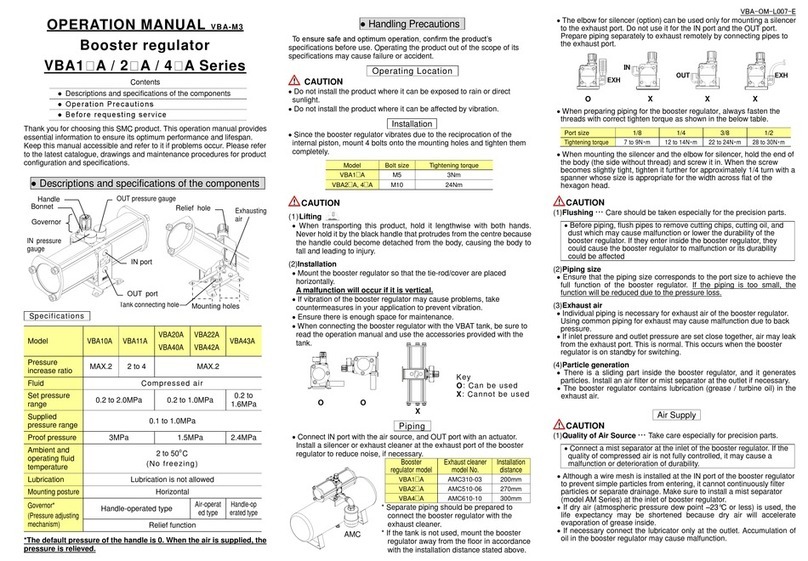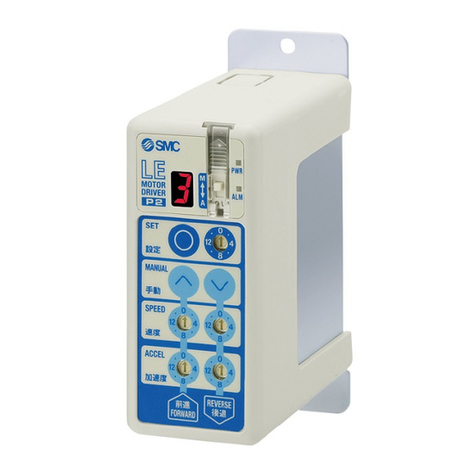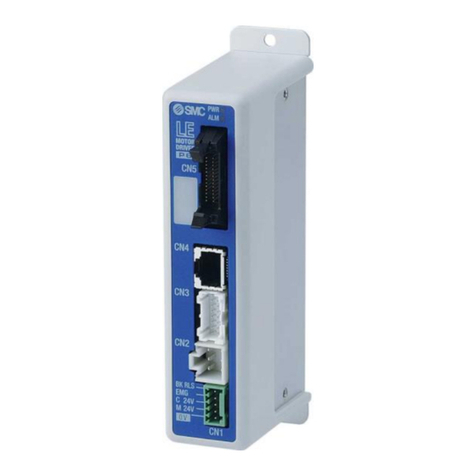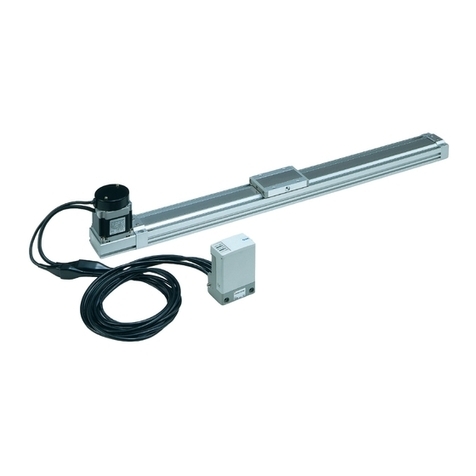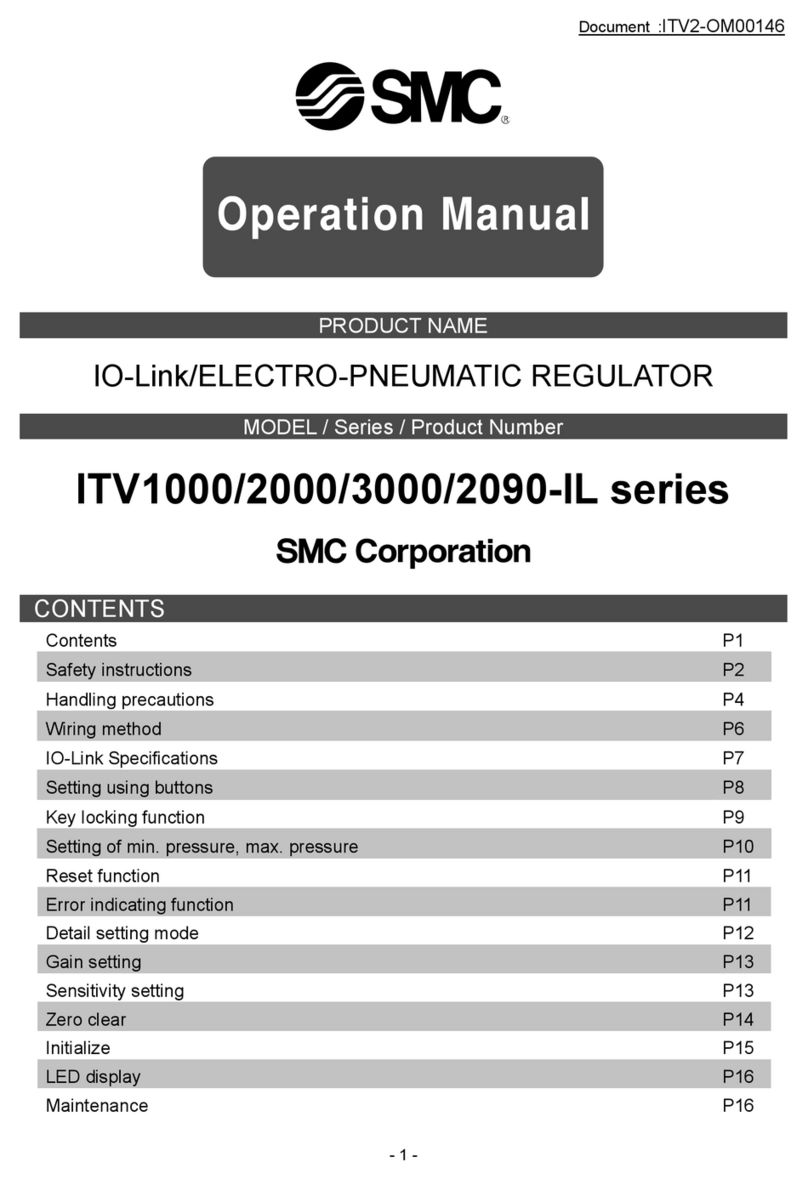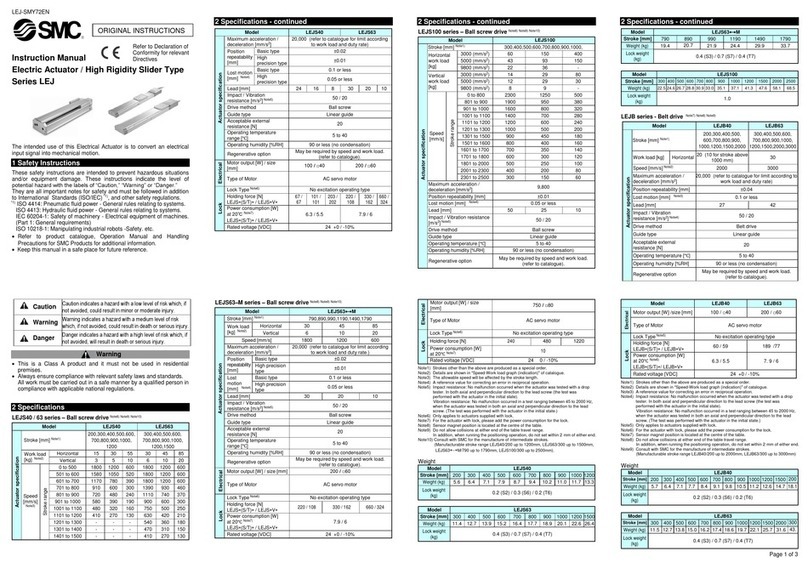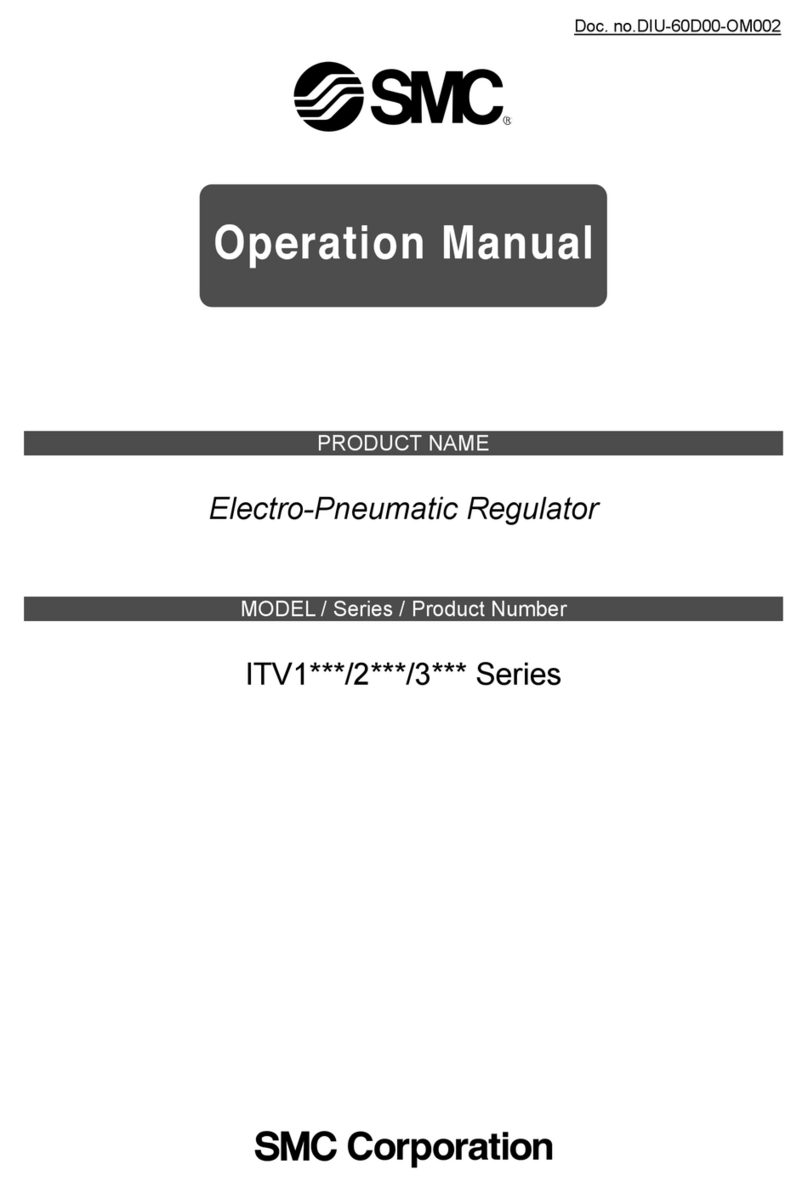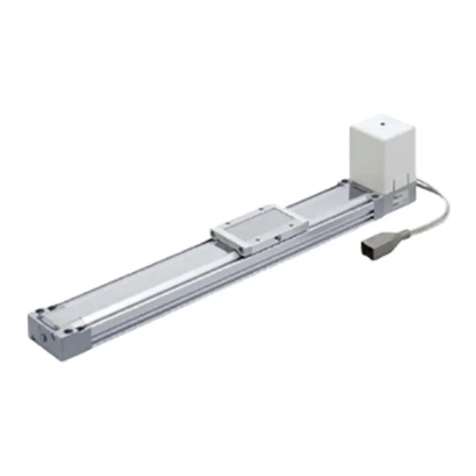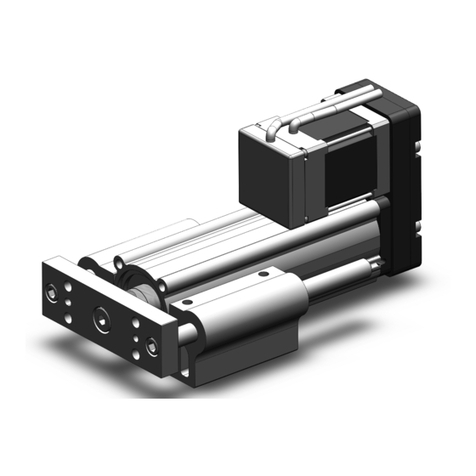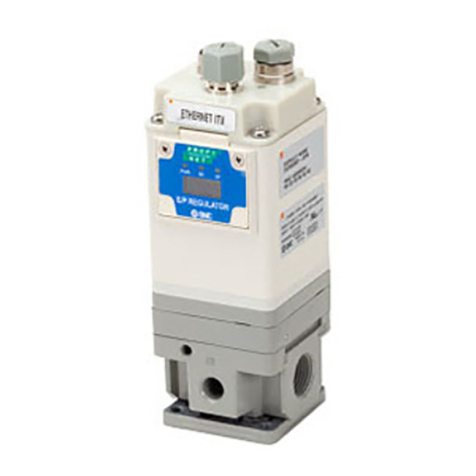Electromagnetic compatibility: This product is class A equipment that is
intended for use in an industrial environment. There may be potential
difficulties in ensuring electromagnetic compatibility in other
environments due to conducted as wellas radiateddisturbances.
Warning
Do not disassemble, modify (including change of printed circuit
board) or repairthe product.
Aninjury or product failure may result.
Do not operatethe product beyond the specificationrange.
Fire, malfunction or equipment damage may result.
Use the product onlyafter confirmingthespecifications.
Do not use the product in the presence of flammable, explosive or
corrosivegas.
Fire, explosionor corrosion may result.
This productdoes not have an explosionproof construction.
When usingthe productas partof an interlocking system:
Provide a double interlocking system, for examplea mechanical system.
Check the productregularly to ensure correctoperation.
Before performingmaintenance,be sureofthefollowing:
Turn off the pow er supply.
Caution
Always perform a system checkaftermaintenance.
Do notuse the product if any error occurs.
Safety cannot beassured if caused by un-intentionalmalfunction.
Provide grounding to ensure correct operation and to improve
noise resistanceof the product.
This product shouldbe individually groundedusing a shortcable.
Follow the instructions given below when handling the product.
Failing to do somay result in product damage.
Maintenance spaceshould always be providedaroundthe product.
Do not removelabels from the product.
Do not drop, hit or apply excessive shock to the product.
Unless statedotherwise,follow allspecified tightening torques.
Do not bend, apply tensile force, or apply force by placing heavy
loads on the cables.
1 Safety Instructions (continued)
Connect wires and cables correctly and do not connect while the
poweris turnedon.
Do not route input/output wires and cables together with power or
high-voltagecables.
Check the insulation of wiresand cables.
Take appropriate measures against noise, such as noise filters,
when the product is incorporated into other equipmentor devices.
Take sufficient shielding measures when the product is to be used
in the followingconditions:
• Where noise due to static electricity is generated.
• Where electro-magnetic fieldstrengthis high.
• Where radioactivity is present.
• Where pow er lines are located.
Do not use the product in a place where electrical surges are
generated.
Use suitable surge protectionwhen asurge generating loadsuch as
a solenoid valveis to be directly driven.
Preventany foreign matter from entering this product.
Do not expose the productto vibrationor impact.
Use the productwithinthespecifiedambienttemperaturerange.
Do not expose the productto any heat radiation.
Use a precision screwdriver withflat blade to adjustthe DIPswitch.
Close thecoverovertheswitchesbeforepoweris turnedon.
Do not clean the product with chemicals such as benzene or
thinners.
2 General Instructions
2.1 Wiring Warning
Adjusting, mounting or wiring change should not be done before
disconnectingthepower supplyto the product.
Electrical shock,malfunction anddamage canresult.
Do not disassemblethe cables.
Use only specified cables.
Do not connect or disconnect the wires, cables and connectors
when the power is turned on.
Caution
Wire the connector correctlyand securely.
Check the connector for polarity and do not apply any voltage to the
terminals other thanthosespecifiedin the OperationManual.
Take appropriatemeasuresagainstnoise.
Noise in a signal line may cause malfunction. As a countermeasure
separate the high voltage and low voltage cables, and shorten thew iring
lengths,etc.
Do not route input/output wires and cables together with power or
high voltage cables.
The product can malfunction due to interference of noise and surge
voltage from power and high voltage cables to the signal line. Route the
w ires of the product separatelyfrompower or highvoltage cables.
Take care that actuator movementdoes not catchcables.
Operate with allw ires and cablessecured.
Avoid bendingcables at sharp angleswherethey enterthe product.
Avoid twisting, folding, rotating or applying an external force to the
cable.
Risk of electric shock, wire breakage,contactfailure and loss of control of
the productcanhappen.
Sele ct “Robotic cable s” in case of inflecting cable(encoder/motor/
rock) repeatedly.
Ref er to the “Driver operation manual” for the bending life of the bending
radius of the cable.
2 General Instructions (continued)
Confirm correctinsulationof the product.
Poor insulation of wires, cables, connectors, terminals etc. can cause
interference with other circuits. Also there is the possibility that excessive
voltageor currentmay be applied to the productcausingdamage.
2.2 Transportation Caution
Do not carry or swing the productby the cables.
2.3 Mounting Warning
Observethetighteningtorquefor screws.
Unless stated otherwise, tighten the screws to the recommended torque
formounting the product.
Do not m ake any alterations to this product.
Alterations made to this product may lead to a loss of durability and
damage to the product, which can lead to human injury and damage to
other equipment and machinery.
When an external guide is used, connect the moving parts of the
product and the load in such a way that there is no interference at
any point w ithinthe stroke.
Do not scratch or dent the sliding parts of the table or mounting face etc.,
by striking or holding them with other objects. The components are
manufactured to precise tolerances, so that even a slight deformation
may cause faulty operation or seizure.
Do not use the product until you verify that the equipment can be
operatedcorrectly.
After mounting or repair, connect the power supply to the product and
perform appropriate functional inspections to check it is mounted
correctly.
When attaching to the work piece, do not apply strong impact or
large moment.
If an external force over the allowable moment is applied, it may cause
looseness in the guide unit, an increase in sliding resistance or other
problems.
Maintenancespace
Allow sufficientspaceformaintenanceandinspection.
2.4 Handling Warning
Do not touch the motor while in operation.
The surface temperature of the motor can increase to approx. 80°C due
to operatingconditions.
Energizing alone may alsocausethistemperature increase.
Asit may causeburns,do not touchthemotor w heninoperation.
If abnormal heating, smoking or fire, etc. occurs in the product,
immediately turnoff thepower supply.
Immediately stop operation if abnormal operation noise or vibration
occurs.
If abnormal operation noise or vibration occurs, the product may have
been mounted incorrectly. Unless operation of the product is stopped for
inspection,the product canbe seriously damaged.
Never touch the rotating part of the motor or the moving part of the
actuator while in operation.
There is a serious riskof injury.
When installing, adjusting, inspecting or performing maintenance
on the product, Driver and related equipment,be sure to turn off the
power supply to each of them. Then, lock it so that no one other
than the person working can turn the power on, or implement
measuressuch as a safety plug.
Caution
Keep the driverand productcombined as deliveredfor use.
The product is setin parameters forshipment.
If it is combined witha differentproductparameter,failure canresult.
2 General Instructions (continued)
Check the product forthe following points before operation.
•Damage to electric drivingline andsignal lines.
•Looseness of the connector toeach power lineand signal line.
•Looseness of the actuator/cylinder and driver mounting.
•Abnormaloperation.
•Stop function
When more than one person is performing work, decide on the
procedures, signals, measures and resolution for abnormal
conditions before beginningthework.
Also designate a person to supervise the work, other than those
performingthework.
An operation test should be performed at low speed, start the test at
a predefinedspeed, after confirming there are no problems.
Actual speedof the product will be changed by the workload.
Before selecting a product, check the catalogue for the instructions
regardingselectionand specifications.
Do not apply a load, impact or resistance in addition to a transferred
load during return to origin.
In the case of the return to origin by pushing force, additional force will
cause displacement of the origin position since it is based on detected
motor torque.
Do not removethe nameplate.
2.5 Actuator with lock Warning
Do not use the lock as a safety lock or a control that requires a
locking force.
The lock usedis designedto prevent droppingof w orkpiece.
For verticalmounting,use theproductwitha lock.
If the product is not equippedwith a lock, the productw illmove and drop
the w orkpiece whenthe poweris removed.
"Measures against drops,” me ans preventing a work piece from
dropping due to its weight when the product operation is stopped
and the power supply is turned off.
Do not apply an impact load or strong vibration while the lock is
activated.
If an external impact load or strongvibration is applied to the product, the
lockw illlose its holdingforce and damage to thesliding part of the lock or
reduced lifetime can result. The same situation will happen when the
lock slips due to a force higher than its holding force, as this will
accelerate thew ear to the lock.
Do notapplyliquid,oilor greaseto the lock orits surroundings.
When liquid, oil or grease is applied to the sliding part of the lock, its
holding forcew illbereduced significantly.
Take “measures against drops” and check that safety is assured
before mounting,adjustment and inspectionof the product.
If the lock is released with the product mounted vertically, a work piece
can dropdue to its w eight.
2.6 Please refer to the auto switch references in “Best Pneumatics “
when an auto switchis to be used.
2.7 Unpacking Caution
Check thereceivedproductis as ordered.
If a different product is installed from the one ordered, injury or damage
couldresult.
